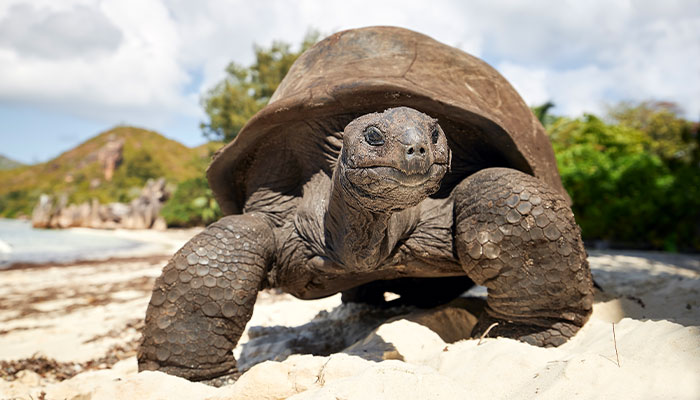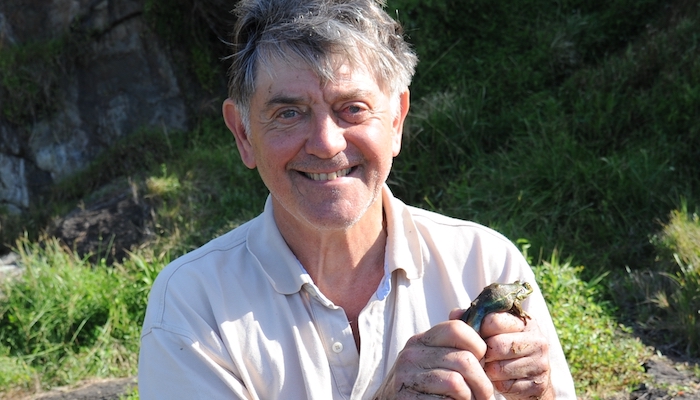A new international study into ageing and longevity across 77 species of reptiles and amphibians has tested a range of theories about these animals’ long lifespans – and found that reproducing young is bad for longevity, but having natural defences against predators is good.

Slowly does it: The giant tortoise can live for more than a century – but why?
However, other theories, such as cold climates being more conducive to long life spans than warmer ones, have been busted.
Published in the journal Science this month, the study, carried out by a team of 114 scientists, is the most comprehensive study of ageing and longevity in reptiles and amphibians in the wild, worldwide.
Animals that can live for more than a century include giant tortoises, easter box turtles, European pond turtles and proteus salamanders – all reptiles or amphibians, like most of the longest-living land animals. Scientists hope these creatures can help us better understand ageing.
With some animals, it’s possible that there may effectively be no degeneration, or very slow degeneration.
The study gathered data on patterns of ageing in reptiles and amphibians from researchers who captured, tagged and released animals back into the wild, observing them for an average of 17 years.
Macquarie University biologist and study co-author Honorary Professor Graham Pyke was an Australian contributor to the research, providing over two decades of lifespan data on the green and golden bell frog.
Pyke has collected data on the endangered green and golden bell frog since 1994, capturing individuals and tagging them with a microchip inserted under the skin.
These frogs typically live for around seven to eight years in the wild, an average lifespan for most frog species, he says, with the oldest frog he recorded living to 13 years old.
Testing hypotheses of ageing
The researchers used the broad range of lifespan data on different species to test four different hypotheses about ageing in reptiles and amphibians.

Natural defence: The green and golden bell frog has a nasty-tasting covering on its skin to deter attackers, an advantage for longevity.
The thermoregulation hypothesis suggests that because reptiles and amphibians (ectotherms) don’t need to constantly warm their internal body temperature, they have a lower metabolic rate and therefore live longer than birds and mammals (endotherms).
“The data didn’t support this,” says Pyke, adding that ectotherms were shown to have a far greater variation in their lifespans than endotherms.
The second hypothesis looked at responses to environmental temperature, predicting that animals living in cold climates would live longer than those in warmer climes.
Whether ageing in reptiles and amphibians provides insights into human ageing remains to be seen.
“Ectotherms can go into a hibernation-like phase in very cold weather, where the metabolic rate slows hugely and everything shuts down,” Pyke says.
However, the data didn’t support this hypothesis either, he says.
The third hypothesis looked at an animal’s protective devices, such as a shell, spikes or skin toxins, which formed a natural defence against predators.
The green and golden bell frog produces a nasty-tasting covering on its skin to deter attackers, Pyke says – and there was evidence that animals with natural defences that protect them from being eaten will have greater longevity.
The fourth ageing hypothesis that was tested (and supported) was the ‘life history pace’ theory – where relatively high early reproduction is associated with shorter longevity.
Lifespan
The study found that certain species show signs of “negligible senescence”, or very slow rates of ageing.

Long haul: Co-author of the study Honorary Professor Graham Pyke (pictured) has collected data on the endangered green and golden bell frog since 1994.
In this context, ageing isn’t about getting slower, or having less capacity, says Pyke.
“Biologically, the most interesting aspect of ageing is the probability that an animal alive today, will still be alive tomorrow or next month,” he says. “Some animals – like giant tortoises – have almost negligible ageing.”
That doesn’t mean these animals won’t eventually die, he says. “With some animals, it’s possible that there may effectively be no degeneration, or very slow degeneration – so the probability that they will die, is no more likely next year, than this year.”
The researchers saw negligible ageing in at least one species in each of the ectotherm groups, including in frogs, salamanders, lizards, crocodilians and turtles.
“The processes of animal ageing and how it impacts longevity are very interesting issues, and comparing these cold-blooded or ectothermic animals, with warm-blooded animals can teach us something about the adaptive nature of these patterns, and warrants further study,” says Pyke.
He adds: “Whether ageing in reptiles and amphibians provides insights into human ageing remains to be seen.”
is Honorary Professor in the School of Natural Sciences.








